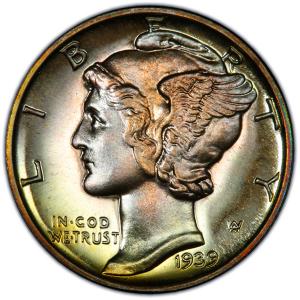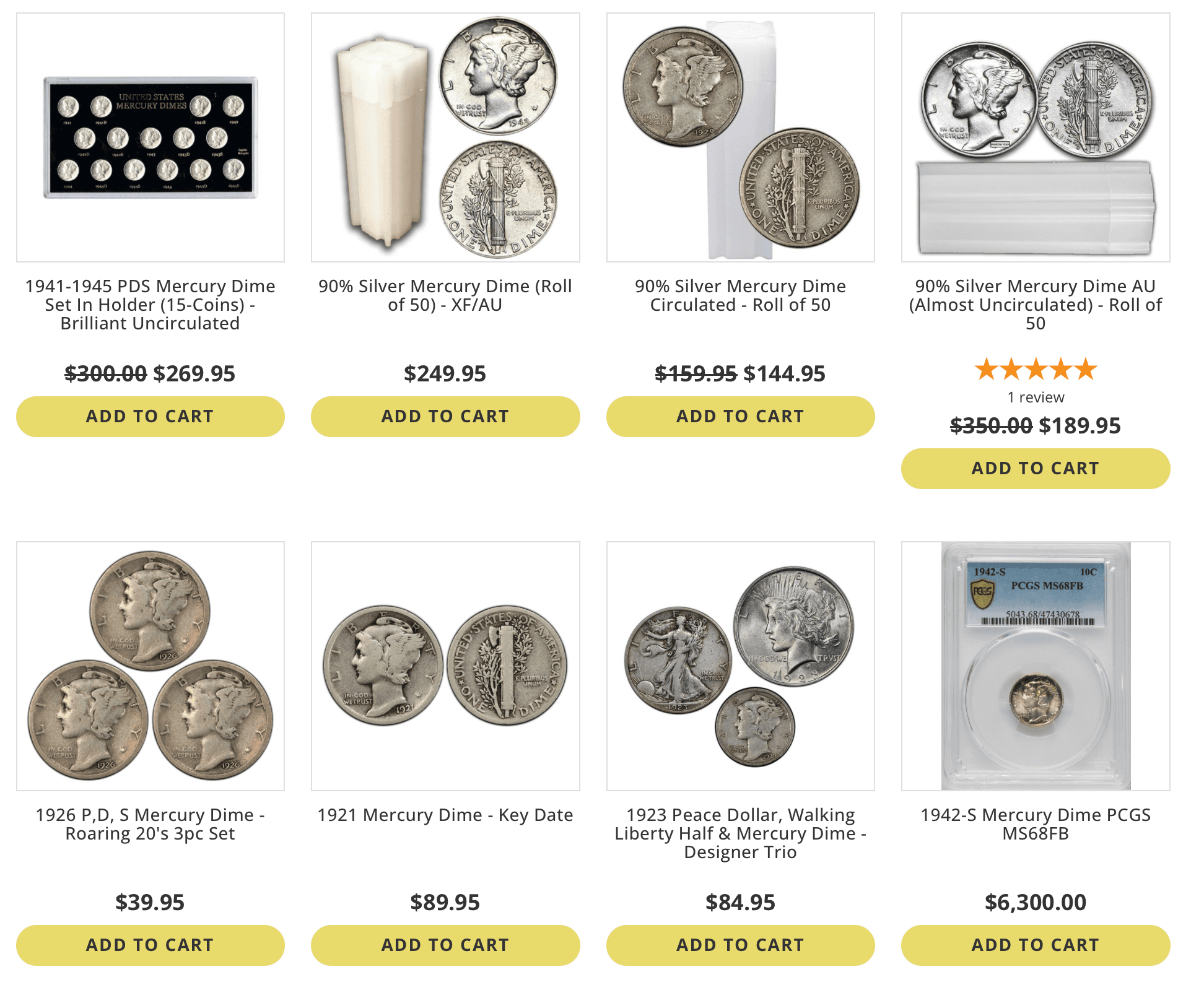A Brief History of the Mercury Dime
Posted by Bullion Shark on Jan 26th 2022
The Mercury dime is a 90% silver, 10% copper ten-cent coin struck from 1916 to 1945 that was designed by famed German-American sculptor Adolph Weinman, who also designed the Walking Liberty half dollar that debuted the same year as his dime. It is unusual for the same artist to create designs for more than one coin issued at the same time with the main exception of Augustus Saint-Gaudens with whom Weinman had studied.
Mercury Dime History
In 1916 the dimes, quarters and half dollars that had been designed by U.S. Mint Chief Engraver Charles Barber had been issued for 25 years since their debut in 1892. By this time Barber’s coinage had become the subject of quite a lot of criticism from an artistic perspective.
An 1890 law stipulated that once the same design has been used for a quarter century, the Mint – with the approval of the Treasury Secretary – could change a coin’s design. At the time, officials at the Mint mistakenly interpreted that law to mean that they were required to change the design of the Barber coinage rather than simply being able to do so.
At the same time, beginning in 1905 following a partnership between then President Theodore Roosevelt and sculptor Victor David Brenner, American coinage of almost every denomination was undergoing a complete renovation that extended to subsequent administrations. In 1907 and 1908 the double eagle, eagle, half eagle and quarter eagle gold coins were redesigned, and the cent and nickel in 1909 and 1913 also saw new designs all of which were greeted with approval for their designs, but which presented certain practical problems for production.
In December 1915, U.S. Mint Director Robert Wooley told the Commission on Fine Arts it should ask a select group of sculptors to prepare designs for the dime, quarter and half dollar. Weinman, Hermon MacNeil and Albin Polasek were asked to submit proposals. Weinman was told by Wooley that in addition to his designs for the dime and half dollar being selected, his design for the reverse of the quarter had also been approved. But the commission persuaded Wooley that one person should not be given so much, so MacNeil was then allowed to design the reverse of the quarter.
All three coins are today iconic coins that are widely collected.
Mercury Dime Design
Weinman’s dime design was inspired by a bust he had prepared of Elsie Stevens, the wife of Wallace Stevens, a lawyer and poet. The couple had rented an apartment from Weinman from 1909 to 1916. The design was also inspired by the face of Victory in his 1909 monumental sculpture in Baltimore called Union Solders and Sailors’ Monument.
The design features a left-facing profile of a female Liberty wearing a pileus or Phrygian cap worn by freed slaves in ancient Rome. That and the fact that the cap had wings resulted in the design being thought mistakenly to be that of Mercury, “messenger to the Roman gods of mythology and quite certainly a male,” according to numismatic researcher David W. Lange.
But Weinman had intended the design instead to symbolize “liberty of thought”. The name Mercury stuck though, which is why although numismatists prefer to refer to the coins as Liberty Head or Winged Liberty dimes, they are still today typically called Mercury dimes.
As for the reverse, that design also resulted in some incorrect interpretations. It showed a bundle of rods with a battle-ax known as “fasces,” which symbolized unity, the battle ax represented preparedness for defense and those elements were surrounded by an olive branch with foliage, which symbolized peace.
The coin was issued at a time when there were increasing calls for the U.S. to come to the aid of Europe and enter World War I. That is why Weinman used motifs that combined the ideas of war and justice with the fasces that had been carried by the guards who accompanied Roman magistrates and the olive for peace.
By mid-1916 no Barber dimes had been struck, and there was a lot of pent-up demand for dimes. But work on the new ones had to be halted when it was discovered that the lettering was not distinct enough. But then another problem surfaced after small amounts of the new coin were sent to vending machine and pay telephone manufacturers who said they were too thick to work in their machines. The dimes were actually not too thick, but their rims were struck too high which resulted in a defect known as a fin. So Weinman modified the design by separating the letters in “Liberty” from the rim and lowering the coin’s relief.
Mercury Dime Production
The Mercury dime entered circulation on October 30, 1916, which is the same day production of Barber dimes was halted. The new design was immediately praised by numismatists, but following initial public enthusiasm, the new coin was not widely collected in the first 15 years or so of its production until the 1930s when coin albums began to be produced, which led to increased interest from collectors.
The coin was issued in large numbers until 1930 except for the 1916-D (which is a key date today with an original mintage of 264,000 coins as a result of a greater need for quarters that year) and from 1921 to 1923 during an economic crisis that reduced the need for circulating coinage. No dimes were made in 1922, which was the first time that had happened since 1826. Mintages were again lowered in 1930 and 1931 during the Great Depression, and no coins were made in 1932 and 1933 again because of low demand during the economic crisis. By 1934 the economy was starting to rebound, and from that period through the series’ end in 1945 mintages were ramped up, which is why those dates (especially the ones from 1941 to 1945, which form a short set).
are today more common than earlier coins. In total, almost 2.7 billion Mercury dimes were struck.
Rolls of the coins in various grades from circulated to almost mint state are readily available today for the more common dates.
Collectors of Mercury dimes should keep in mind that the lower relief of the reverse side of the coin resulted in that side becoming more worn than the obverse over time. In addition, even on mint state coins the horizontal bands of the fasces often do not show full detail, or what is called “full bands” or “full split bands”. Coins with FB command higher prices and should be sought when possible.
In 2016 a gold version of the coin was issued to mark the centennial of its debut in 1916. And the obverse design was reprised for the American Palladium Eagle issued since 2017.




